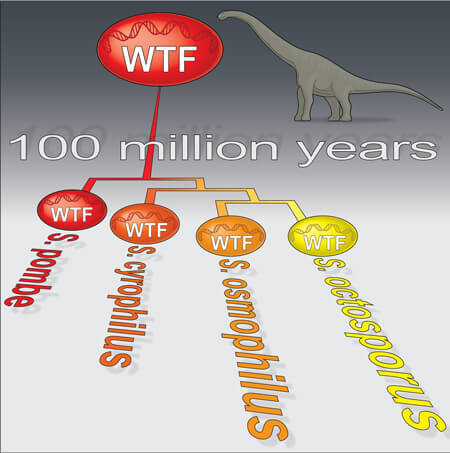During meiosis, the specialized cell division that gives rise to
reproductive cells like sperm and eggs, the inheritance of genetic
material from a set of chromosomes from each parent is 50/50, or equally
probable for each reproductive cell.
Meiotic drivers in yeast are in fact a more potent genetic parasite. The wtf
gene family are killer meiotic drivers; they not only transmit the
selfish gene to over 50 percent of offspring but then destroy the
reproductive cells—or spores in yeast—that do not inherit the drive
gene.
Natural selection in a genome typically rescues a species from
selfish genes by favoring genes that suppress, or silence drive,
rendering it useless. How the wtf gene family evaded suppression is largely due to their rapid rates of mutation.
This persistence alters our perception of how a species can overcome
the expected increase in infertility that typically leads to extinction.
It also changes the way scientists may look for and identify families
of selfish genes in different species, including humans.
“Until now, when looking for candidate drivers within a genome, I
wouldn’t have considered “old” genes as a possibility,” said Zanders.
“Since selfish genes are major drivers of evolution, this new finding
opens the door for thinking about how drivers can have persistent,
long-term effects on genome evolution.”
Additional authors include Ananya Nidamangala Srinivasa, R. Blake
Billmyre, Ph.D., Jeffery J. Lange, Ph.D., and Ibrahim M. Sabbarini.
This work was funded by the New Innovator Award of the National
Institutes for Health (award: DP2GM132936), institutional support from
the Stowers Institute for Medical Research, the Chinese Ministry of
Science and Technology, and the Beijing Municipal Government. The
content is solely the responsibility of the authors and does not
necessarily represent the official views of the NIH.
About the Stowers Institute for Medical Research
Founded in 1994 through the generosity of Jim Stowers, founder of
American Century Investments, and his wife, Virginia, the Stowers
Institute for Medical Research is a non-profit, biomedical research
organization with a focus on foundational research. Its mission is to
expand our understanding of the secrets of life and improve life’s
quality through innovative approaches to the causes, treatment, and
prevention of diseases.
The Institute consists of 17 independent research programs. Of the
approximately 500 members, over 370 are scientific staff that include
principal investigators, technology center directors, postdoctoral
scientists, graduate students, and technical support staff. Learn more
about the Institute at www.stowers.org and about its graduate program at www.stowers.org/gradschool.
Media Contact:
Joe Chiodo, Head of Media Relations
724.462.8529
press@stowers.org




